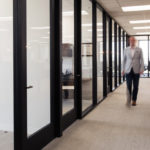By Kevin Beaumonte & Matt Geist
After nearly a ten-year run of consistent rental growth and strong market fundamentals, the commercial real estate industry, including nearly all real estate product types, has suddenly found itself faced with extreme challenges.
COVID-19 has been a brutal shock to the world economy and the economic spillover into the commercial real estate industry is just beginning.
The East Bay’s office market experienced a stagnant second quarter, with extremely limited tenant demand and an uptick in both direct and sublease space availability. The quarter ended with a total availability rate of 11.8%, up from 11.4% in the first quarter and 11.1% at the beginning of the year. With several large block subleases and more direct space expected to come available in the second half of 2020, vacancy is anticipated to increase further throughout the year. Perhaps more surprising, given the strength of the industrial sector elsewhere in the country, the East Bay has the most industrial & flex space available the market has seen in six years. This consists of a total of 22.3 million square feet, up 13.2% from the first quarter. Sublease availability has soared from 2.2 million square feet to 3.2 million square feet year to date (YTD), which is a 45.5% increase and marks the highest amount of industrial sublease space in the market since the third quarter of 2010.
The East Bay is driven by four incredibly diverse submarkets; the Greater Oakland office market, the I-880 Corridor industrial/flex market, the Tri-Valley office/flex market, and the N-680 Corridor office market. While each of these submarkets operate as their own economy, collectively they make up the East Bay’s commercial real estate landscape. Though each vary greatly from product type to tenant industry sector, none of these markets have been immune to the effects of COVID-19.
Industrial
While there is no question that the fundamentals are shifting to be less landlord favorable, the industrial market is in a much better position to weather this storm than the office space sector. There are both macro and micro differences between the situations that office and industrial find themselves in today.
First, the amount of industrial space available going into this crisis was at such a low point that it created a severely landlord favored market, which is why we saw rental growth exceed 6.75% per year on average for the past decade as rents rose from their post Financial Crisis low of $0.65 per square foot triple net to $1.25 per square foot triple net ending for the second quarter of this year.
Second, industrial is more insulated from the effects of the virus due to its greater dependence on tasks that must be completed in-person within the space and allows for much easier distancing than office space, which usually will have densities that exceed warehousing space by a minimum factor of at least four, but often times much higher.
Lastly, while there is no question that there will be serious and long-term implications for consumer spending in the coming years, industrial is poised to benefit from our country’s all-important supply chain, supporting an overnight surge in online purchases.
Industrial demand on the I-880 Corridor was among the steadiest throughout the East Bay from 2013 through 2019, during which time rents increased by 76%. Due to a sharp drop in tenant demand and several new subleases coming to market, the availability YTD has grown by 3.2 million square feet bringing the vacancy from 7.3% to 9.2%. 1.02 million square feet of this new availability is sublease space, with the majority of options being between 5,000 to 25,000 square feet in size. All things considered; the market is still relatively healthy on paper, but availability is increasing at an alarming rate. Leasing activity was down by 32% in the second quarter and is on pace for a slightly less active third quarter currently.
Office
The Oakland office market ended the second quarter with an availability rate of 9.1%, showing a 1.2% increase YTD, or in real numbers, a 594,000 square foot increase in availability. While Oakland has benefited greatly from the San Francisco tenant spillover over the past several years, the inflection point for the market’s increasing availability was in 2016, when it hit a 15 year low with 7.2% availability. Since then, 1.1 million square feet of newly constructed office space was added to the inventory. New construction, which added to the market’s direct vacancy, and increasing amounts of sublease space, have been the main drivers for the rising availability rate. Further, sublease space in the Oakland office market has increased 19.1% YTD with more than 100,000 square feet expected to come available in the next 60 days.
The vacancy in the Tri-Valley has reached a two year high, with 4.3 million square feet of the 30 million square foot market available for lease. Of the 4.3 million square feet currently available, 27% is comprised of sublease space which equates to 1.16 million square feet. While it is important to note that sublease availability has been a significant trend since the start of 2019 and not greatly COVID-19 related thus far, many companies who would have overlooked the sublease market in the past are now considering these options due to low start-up cost, below market rents and flexibility in the length of lease terms. Now that sublease space is becoming of consideration, and growing in the Tri-Valley daily, it is impacting rental rates and concessions being offered by landlords. Even before this pandemic, there was a growing softness in certain product types throughout the Tri-Valley. For example, Class A office has an availability rate of 16.26% compared to the market’s overall availability rate of 14.48%. Class A office also has the most sublease space available, accounting for 78% of the 1.16 million square feet. Historically speaking, competition is accelerated between landlords when both direct and sublease vacancy are increasing simultaneously.
The N-680 office market has seen Class A rents increase by more than 50% in the past 5 years due to an overwhelming amount of capital markets activity. The catalyst for the strong year-over-year rent increases was partially due to lofty underwriting from institutional investors and significant capital improvements made to each asset. During the same time, vacancy has increased from 14.2% to 19.8%. Class A rents may have been sustainable during a robust economy, but with underutilized office space and dried up leasing activity, rents will inevitably decline. Landlords now have to compete with an increasing inventory of discounted sublease space, further impacting direct rents and building values.
While most of the commercial real estate industry is beginning to acknowledge the direction things are headed, there is little agreement among landlords and brokers as to just how bad the damage will be when the dust settles. Most landlords have not changed their asking prices since pre-COVID pricing, and there have been very few market clearing transactions to justify to what extent rents have gone down, or will go down. However, we think the damage to the both office and industrial markets is severe, and will be getting worse by the month.
Please remember that while we represent tenants, we wish no harm to landlords. The reality is that a strong commercial real estate market is the byproduct of a robust economy. A commercial real estate market in distress is likewise the sign of a recession, which we have been through three times in our careers. We take no pleasure in reporting on the market’s coming decline, but our commitment to our clients and the market is to be transparent and truthful as to what we are seeing and where we think the market is going.
There are four major pressures on the office market that will add massive supply in the coming years, and ultimately put the office market in complete distress by the end of 2021.
1. Sublease inventory is rising.
Every day we talk to companies that have no intent to re-occupy their space and the only contractual way out of the obligation is to put it on the market for sublease. These almost always are priced at a discount to the market, typically by 10 to 20%, and sometimes more. In past recessions, when tenants become competitors to landlords, it ends badly for the landlords when tenants slash their prices in order to cut the bleeding, which they can do as they aren’t worried about maintaining market rents in order to preserve asset values like most landlords.
2. Some tenants have opted out of renewing their leases.
With no clear sign of a vaccine, therapeutic, or date on when the stay at home order could be lifted, we are seeing some office tenants with leases expiring this summer and into the fall opt out of having office space at all, and working remotely into 2021. This is causing more space to come onto the market unexpectedly.
3. Landlords are underreporting the number of Tenants behind in rent payments.
An increasing number of tenants, mostly small and medium size businesses, are in default on their leases. It’s been reported by large office building landlords that anywhere from 5% to 10% of their tenants are in default. Based on the thousands of conversations, phone calls, online polls, and zoom meetings over the past few months, we are not confident in the landlord data being circulated and we believe the number of tenants in default is much higher. Some tenants have been using PPP money to pay the rent, which is depleted for the most part at this point, putting even more tenants at risk of default in the coming months. When the courts open up and landlords can file to evict those tenants, or tenants have to wind down and dissolve their businesses, a sizable amount of office space will be coming back to market by the end of the year in increments between 2,000 and 10,000 SF, increasing vacancy.
4. There is a “resizing” of Corporate America coming.
As leases expire in 2021-2023, companies are going to be downsizing their office lease obligations as the layoffs have settled through the economy and companies find that anywhere from 10% to 25% of their employees will have become comfortable and effective remote working on a permanent basis. Also, a significant percentage of employees will continue to work on a semi-remote basis for the foreseeable future. We have heard some landlord brokers advancing the theory that companies will need to expand their workspace to provide more social distancing between employees, and therefore increase their total space requirements. However, the marginal increase in square footage needed by some companies will easily be accommodated in their current footprint. Any need for increased social distancing will be more than offset in multiples by the shedding of space one tenant at a time as future office leases expire. Most tenants with leases expiring in the next three years will be getting smaller, the net effect of which is called “negative net absorption,” whereby millions of net square feet of office space will be coming onto the market in the coming years, 3,000, 10,000, and 15,000 SF at a time. It will be death by a thousand slices, and while landlords’ brokers that are being called upon to backstop building owners and provide price support are claiming that they have not seen a significant uptick in vacancy, it’s coming. It’s like a wave on the horizon that looks like it’s going to be something you could surf, only to realize that as it nears it’s actually a crushing tsunami wall of water. As discussed above, there have been meaningful changes, but more is on the horizon and it will soon be undeniable even to the most steadfastly optimistic landlords.
What Lies Ahead
The coming surge of supply in the next 18 months will undoubtedly put a downward pressure on rental rates and create a strong tenant’s market. For companies that make it to the other side of the crisis, there will be tremendous opportunities in the market, and pricing will likely be 20 to 30% below what tenants used to pay in pre-COVID days. The number of quality sublease opportunities and also lease renewal and restructuring opportunities will be abundant.
Some landlords, still in denial of the tsunami headed their way, are going to make tempting offers to tenants this year with only modest rent reductions in exchange for extending leases. Of course, there are always exceptions to the rule, and there will be sound reasoning for some companies to transact in the near term, such as landlords who are already providing aggressive double-digit percentage decreases in proposed rents and for companies that have a strategic reason for being in the market today. Each submarket, client situation and assignment is different, and it is important to set a specific strategy and objective for your particular circumstance.
Kevin Beaumonte is a vice president at Hughes Marino, a global corporate real estate advisory firm that exclusively represents tenants and buyers. Contact Kevin at 1-844-662-6635 or kevin.beaumonte@hughesmarino.com to learn more.
Matt Geist is a vice president of Hughes Marino, a global corporate real estate advisory firm that exclusively represents tenants and buyersn. Contact Matt at 1-844-662-6635 or matt@hughesmarino.com to learn more.










